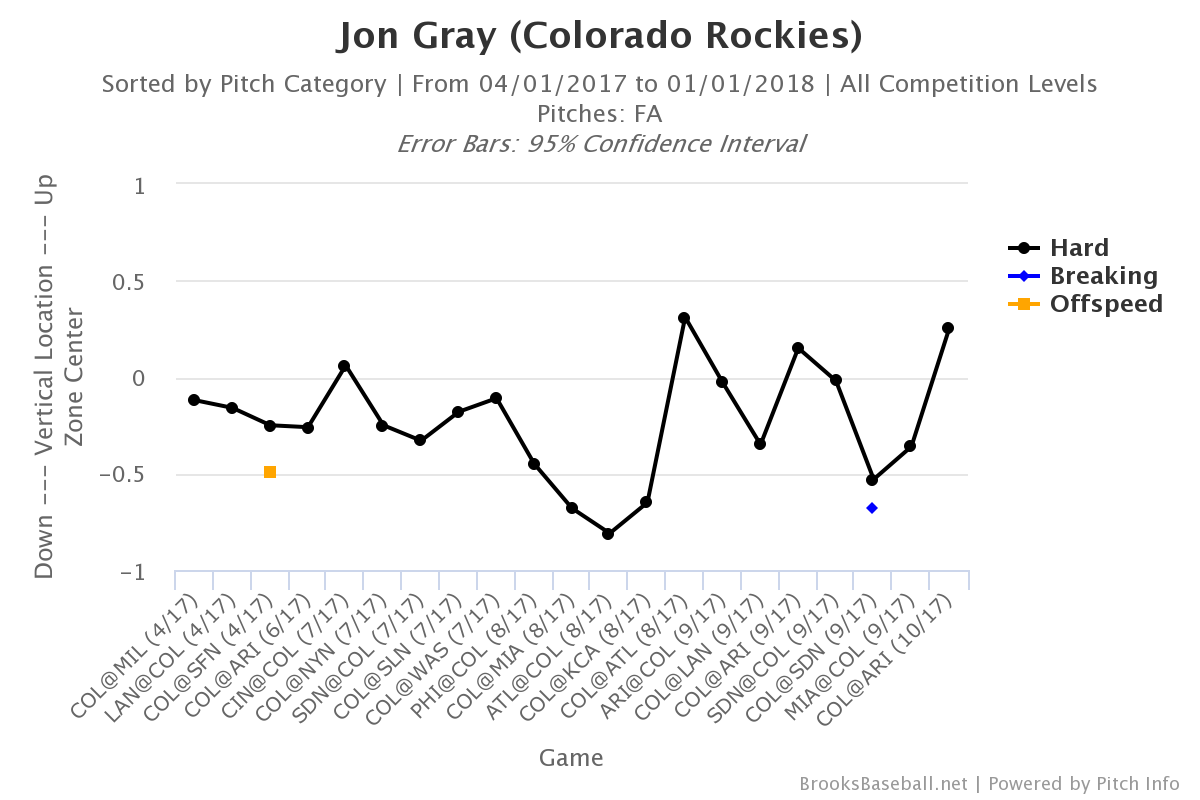© 2025 ALLCITY Network Inc.
All rights reserved.

By the time you’re done reading this story you’re going to think to yourself, ‘the only thing left for Jon Gray to do is to pitch this well for 200 innings.’
Colorado Rockies right-handed starter Jon Gray is elite. He’s one of the 20 best pitchers in baseball.
Hear me out.
In a season in which Gray’s first half was derailed by injury and his several starts after were hampered by the recovery, the only thing that held him back from being in the conversation for Cy Young was usage.
Over his 20 start, 110 innings pitched 2017 season Gray posted a 10-4 record with a 3.67 ERA and 3.18 FIP which amounted to a 3.2 fWAR/3.1 rWAR.
What does all that mean? He was really good. But how good?
His unadjusted ERA (he pitches at Coors Field mind you) was 40th among the 149 starters that threw 90 or more innings, his FIP (another unadjusted for park stat but which factors out things out of Gray’s control theoretically) with the same parameters as before was 13th-best in the game.
Take the sample and extend it out over 200 innings and Gray was comparable to, if not better than, Zack Greinke last year. Without even making an adjustment you can do this.
Over Gray’s last two seasons, he’s pitched 268 innings. Among starters with at least 250 innings over the past two seasons, Gray’s 77 FIP- ranks 8th-best in the majors. That essentially means he was 23% better at run prevention than the league average.
There’s a case to be made for track record but the reality is that recently Gray has been just as good as anybody not named Clayton Kershaw, Max Scherzer, Chris Sale or Corey Kluber.
The change that occurred between 2015 and 2016 is that his curveball went from a pitch he was on the verge of abandoning to one of the most dangerous on the Rockies’ staff.
A twitter account that only tweets videos of Jon Gray’s road curveball pic.twitter.com/VbrVhcAdve
— Jake Shapiro-ho-ho-ho (@Shapalicious) September 23, 2017
Jon Gray 7 IP, 2 ER, 10 Ks… what in the hell is this alien pitch pic.twitter.com/t5XcUcUfpa
— Jake Shapiro-ho-ho-ho (@Shapalicious) September 13, 2017
Giancarlo Stanton is NOT A FAN of Jon Gray pic.twitter.com/V6coYTccW8
— Jake Shapiro-ho-ho-ho (@Shapalicious) September 27, 2017
How important is Gray’s curve?
The in-zone swing rate on his curveball decreased by 11 percentage points between 2016 and 2017 all while out-of-zone swings on his curve increased 14 percent. Not only does this mean his curve is an out pitch but it’s one that benefits his entire repertoire by keeping batters off balance.
Further, Gray’s opponents swing percent on all of his pitches was 66% in 2016, in 2017 it fell to 58% of the time. This is huge. Those are basically free strikes without any chance of damage because Gray’s deception increased eightfold.
What happens when Gray’s curveball isn’t working?
The 2017 National League Wildcard game is the answer. His curveball is now an essential pitch.
That’s not to discredit his fastball or slider at all. Both have remained incredibly good pitches, with his slider bordering on being the best amongst starters in baseball.
Backdoor slider to get Yelich looking… Jon Gray pic.twitter.com/jKDJKBh8Vv
— Jake Shapiro-ho-ho-ho (@Shapalicious) September 27, 2017
Along with his curve, it’s been a growing confidence that has turned the former No. 12 ranked prospect in all of baseball into one of its best dozen pitchers.
Before facing Kershaw for the second time last season and subsequently handing the Dodger ace a second consecutive head-to-head loss Gray told BSN Denver, “I just like to go show it off. It’s a game where you’re the underdog and it’s going to be a lot of fun, it’ll be a good atmosphere. I’m just going to go out there and show what I got, try to be the guy, make a difference, be nasty. Do whatever you can to shove.”
One more thing that has shown that Gray has matured to a savvy level despite not even making 60 MLB starts.
Gray has figured out Coors Field by having a different plan of attack at home compared to on the road. Although we’ve covered it before at BSN Denver, it’s become clear by just displaying two stats. At home, Gray is more of a groundball-inducing version of himself, striking out 8.02 per nine while having a grounder rate of 56.3%. On the road, his strikeouts per nine was 9.93 last year with a groundball rate of 43.3%.
How is he doing this? He’s changing the vertical location on his fastball, throwing it higher when on the road. Why? Simple. Avoid the home run. But the correlating effect is that he’s not using as much of the strike zone, which lets hitters key in on a smaller part of the zone at Coors Field. But once again because his deception has grown, those hitters aren’t squaring balls up.
Gray has already become one of the best pitchers in Rockies history; he’s already become one of the best pitchers in baseball when he’s on the hill. The only reason why Gray hasn’t been talked about as such is the lack of innings.
Give Gray an entire season in 2018 and there’s a good chance he’ll have the greatest single season by a hurler from Denver. The only thing left for Jon Gray to do is to pitch as well as he has for the past 200 innings for the next 200 and do it over one season. If he does, Gray will be the first Rockie to be awarded the Cy Young.
Comments
Share your thoughts
Join the conversation




